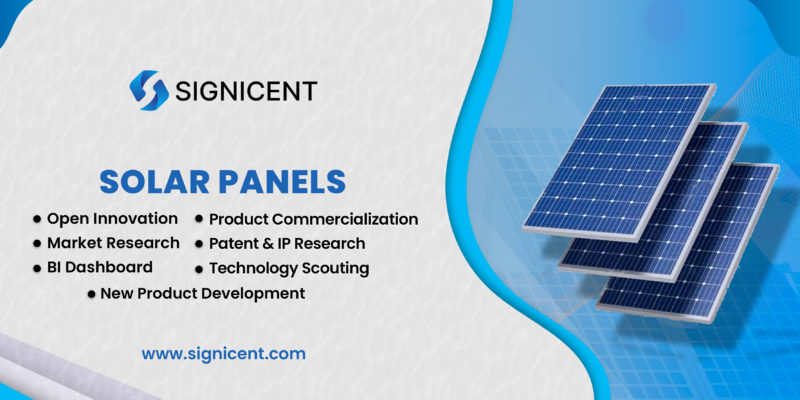The solar panel report will explore emerging, novel, and innovative technologies that use monocrystalline cells. The report also sheds light on the challenges associated with the solar panel industry. Also, the solar panel report talks about the significance of monocrystalline cells for market growth. Top key players and startups have been covered in this report as well.
Technology shift in the solar industry has been taking place rapidly across the globe. The solar industry has almost entirely moved away from the polycrystalline, and polycrystalline passivated emitter and rear cell (PERC) based cells to more efficient mono-crystalline cells.
Polycrystalline solar panels are made from silicon. However, instead of using a single crystal of silicon, manufacturers melt many fragments of silicon together to form the wafers for the panel. Polycrystalline solar panels generally have lower efficiencies than mono-crystalline cells.
Mono-crystalline solar cells are formed from single-crystal silicon. Because the cell is composed of a single crystal, the electrons that generate a flow of electricity have more room to move. As a result, mono-crystalline panels are more efficient than their polycrystalline counterparts.
The mono-crystalline solar cell (Mono-Si) market is expected to witness market growth at a rate of 5.70% in the forecast period of 2020 to 2027.
Adjustable Photic Angle’s Solar Panel: A solar panel of adjustable photic angle that can rotate 360 degrees to possess a solar panel that carries out the regulation of angle and effectively utilize solar panel, increasing solar panel generating efficiency.
Photovoltaic Solar Energy Electroplax: A photovoltaic solar energy electroplax is convenient to mount comprising of a supporting platform and a solar panel body detachably mounted on the supporting platform through a clamping assembly and the height of the supporting platform is adjusted through a lifting assembly arranged at the bottom of the supporting platform.
Global mono-crystalline Solar Panel Market
This section of the solar panel report sheds light on the global market. Technological advancements have fuelled up the global market.
The Global mono-crystalline Solar Panel Market is estimated to be USD 14.13 billion in 2019 and is growing at a CAGR of 15.0% during the forecast period of 2020-2025 to reach USD USD 32.68 billion by 2025.
Drivers :
Increasing demand for solar panels on the residential rooftop. Rising environmental concern leads to the adaption of solar energy across the world. Increasing government incentives and reduction in taxes for solar energy. Decreasing the cost of PV and energy storage systems.
Start-ups
This section of the solar panel report sheds light on the start-ups.
EcoSolifer is a vertically integrated Swiss Company involved in PV power generation. Their heterojunction technology delivers solar cells with higher levels of energy efficiency while having fewer steps in the production process.
Australian startup Kuga Electrical delivers full-service commercial solar installations based on mono-PERC solar cells. Their solar panels are built with PERC technology and allow for energy-dense solar installations.
Dutch startup Energyra combines innovative cells and MWT technology. They manufacture lightweight mono-crystalline solar modules suitable for both rooftop applications and commercial projects.
Australian startup SolAround develops a proprietary solar photovoltaic p-PERT cell technology and manufacturing process. They create bifacial solar cells and panels that maximize energy density and significantly reduce the Levelized Cost of Energy (LCOE) for PV plants.
Each year Signicent provides consultancy to hundreds of organizations to help transform their innovations to value.
Key Players
This section of the solar panel report sheds light on the key players.
Founded in 2001, Suntech has supplied over 22GW photovoltaic modules to more than 100 countries. Its employ turnover is around 17,000 and annual turnover is over $5.2 BILLION. It has its HQ in Wuxi, China
Founded in 2005, JA Solar is a manufacturer of high-performance photovoltaic products. With 12 manufacturing bases and more than 20 branches around the world the company has an employee turnover of around 22000 and has annual sales revenue of around $200 MILLION. Its HQ is in Beijing, China
SunPower Corporation is an American energy company that designs and manufactures crystalline silicon photovoltaic cells and solar panels. Employ turnover of 8400 and an annual sales turnover of over $1.8 BILLION. It has HQ in San Jose, California, United States.
JinkoSolar (NYSE: JKS) is one of the largest and most innovative solar module manufacturers in the world. Its employ turnover is around 15,195 and its annual turnover is over $4.23 BILLION. It has its HQ in Shanghai, China
Mergers and Acquisitions in Solar Panel Report
This section of the solar panel report sheds light on the mergers and acquisitions that have happened in the
Gintech, NSP and Solartech to merge
In October 2017, three of Taiwan’s merchant solar cell and module producers, Gintech Energy Corp, Neo Solar Power (NSP), and Solartech Energy have officially announced plans to merge and exit the ‘foundry’ business model they were founded on.
Home-Solar Companies Merge as Coronavirus Dims Growth
Sunrun Inc. RUN -0.06% is acquiring Vivint Solar Inc. VSLR 0.19% in an all-stock deal, the companies said late Monday. The transaction values Vivint at $1.6 billion, excluding debt, according to Sunrun.
Recent Developments in Solar Panel Report
This section of the solar panel report sheds light on the recent developments that have happened in solar panels.
In July 2020, JinkoSolar (China) achieved a solar conversion efficiency of 24.79% for large-area N-type mono-crystalline silicon solar cells. The record-breaking mono-crystalline silicon solar cell was fabricated on a high-quality CZ mono-Si substrate, with a practical size of 267.72cm2, and several advanced technologies have been implemented to achieve this new record of 24.79%, including passivating contact technologies, advanced diffusion system, surface passivation, and advanced anti-reflection technologies, and a series of the material upgrade were integrated into the cell process.
In June 2020, a group of scientists from Saudi Arabia’s King Abdullah University of Science and Technology (KAUST), the University of Jeddah, and the University of California, Berkeley, have demonstrated an interdigitated back contacts (IBC) spherical solar cell with stronger heat-dissipation and reduced dust accumulation compared to conventional flat solar cells achieving a reported efficiency rate of 18.93%. Through a corrugation technique, the research group was able to develop a cell with 138 μm-wide grooves. This made it possible to achieve a flexible structure with a total area loss of only 5.6%.
In February 2020, Innovative Solar Power (Canada) introduced patent-pending breakthrough technology that delivers an encapsulated solar module that uses 1/20th of the PV cells of traditional panels by incorporating conic reflective troughs that multiply sunrays by 20x, resulting in lower-cost alternative to traditional solutions, while improving performance. The ISP module incorporates single-junction mono-crystalline silicon with improved collector performance and a large bus conductor to reach world-record level efficiencies.
In February 2020, researchers in St. Petersburg (Russia) created a tiny prototype of a high-efficiency solar cell using gallium phosphide and nitrogen. They began with a silicon substrate, or wafer, which is a thin slice of crystalline silicon. On top of that, they grew a layer of pale orange gallium phosphide. When combined with nitrogen, the compound demonstrated a direct bandgap and was “great” at absorbing light, they said. The cell’s single photoactive layer showed a solar efficiency of 2 percent.


